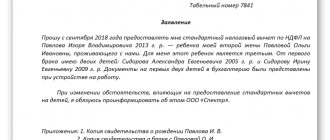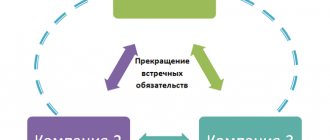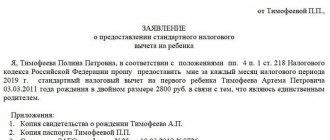Offsetting mutual claims and VAT in 2020 in the absence of termination of the contract
Where to find a sample act and agreement on the offset of mutual claims, sample 2020
The problem of deducting VAT from an advance payment under a terminated contract, offset as a counter-obligation
Officials' view on the deduction of VAT from an advance payment under a terminated contract, offset as a counter-obligation
An alternative point of view regarding the deduction of VAT from an advance payment under a terminated contract, offset as a counter-obligation
Results
Offsetting mutual claims and VAT in 2020 in the absence of termination of the contract
Currently, the offset of mutual claims under the Civil Code of the Russian Federation, which occurs in terms of existing debts under existing agreements and, in essence, is a form of debt payment, does not entail any consequences in relation to VAT, despite the fact that in the documents formalizing the offset mutual requirements according to the sample, its amount is indicated. This is due to the fact that the acceptance of VAT for deduction on goods, works, services purchased on the territory of the Russian Federation, starting from 2009, is in no way related to the fact of payment of this tax.
Read more about the deduction procedure in the article “What is the procedure for applying (accepting) tax deductions for VAT: conditions?” .
Thus, in order to make a deduction for purchases made in the Russian Federation, the simultaneous presence of 3 circumstances turns out to be important (Articles 171 and 172 of the Tax Code of the Russian Federation):
- the purchase is intended for use in transactions subject to VAT;
- the purchased item has been capitalized;
- there is an invoice issued without errors critical for deducting VAT.
Offsetting mutual claims in such a situation represents the repayment of mutual debts (payment), which are not reflected in the fact of the deduction.
Find out about the tax and accounting consequences of offsetting mutual claims in the Transaction Guide by receiving free trial access to the ConsultantPlus system.
Drawing up an agreement on mutual offset: what to pay attention to {q}
https://www.youtube.com/watch{q}v=r8H9dRanWik
The form must also indicate the date on which the offset is considered completed (on this day the entries in the balance sheet should be reflected). You can attach a reconciliation report to your application, which will confirm the existing debts between you and the counterparty. Complete the application in 2 copies, sign it with your manager and seal it.
Give one of the copies to the counterparty under personal signature; this form will serve as the basis for you to reflect offset transactions in the balance sheet. Leave the second copy of the application with the counterparty. If you do not have the opportunity to transfer the bank to the debtor personally against signature, send it by letter with notification. Method 2: Two-way application. This procedure differs from the previous one in that you and the counterparty mutually draw up and sign an application.
We invite you to read: Dismissal by agreement of the parties and receipt of compensation
1. The agreement must necessarily reflect the following information:
- on the composition of obligations that are repaid as part of the offset;
- contracts and other documents of title (acts, invoices, invoices) under which obligations arose;
- financial value of the claims.
2. It is advisable to provide motivational formulations justifying its preparation.
For example, indicate that the agreement is drawn up in order to simplify and increase the efficiency of calculations between the parties.
3. In the agreement, it is advisable to indicate that the mutually offset claims are homogeneous, and to provide the main sign of their homogeneity (for example, indicate that financial obligations in rubles, similar goods in pieces, similar services in specific units of volume are offset).
4. It is advisable to reflect in the agreement the balance of debt of either party, since it is likely to arise as a result of mutual offset.
It would be appropriate to indicate in the preamble or other part of the agreement that it is drawn up on the basis of the provisions of Art. 410 and 411 of the Civil Code of the Russian Federation.
Whereas in order to set off, the document must contain a clear and unambiguous indication of the termination of the obligations of each party. After signing the reconciliation report, you (or your counterparty) write a letter (application, notification) to the other party.
Officials' view on the deduction of VAT from an advance payment under a terminated contract, offset as a counter-obligation. Officials explain that, on the basis of Art. 407 and 410 of the Civil Code of the Russian Federation, when counterparties offset mutual claims, obligations are considered terminated if the previously mutually received amounts of advance payments were returned. And these amounts are considered returned.
The FAS of the Central District confirms that if, upon termination of contracts between counterparties, both parties terminate their mutual obligations by offsetting previously received advances, then taxpayers have the right to deduct VAT previously paid on advance payments (resolution of the FAS of the Central District dated May 26, 2009 in case No. A48 -3875/08-8).
Offsetting is a fairly common operation in the accounting environment, which allows you to completely terminate mutual obligations between the parties in the most convenient way.
The article will help you correctly carry out and formalize the offset of mutual claims. One of the methods of settlements between organizations is offset.
Changes in legislation One of the main changes in legislation regarding VAT accounting when offsetting claims was introduced on 01/01/08.
https://youtu.be/https://www.youtube.com/watch?v=eXfiKtKvk50
Where to find a sample act and agreement on the offset of mutual claims sample - 2020
To offset mutual claims, you will need either an act of offset or an agreement on offset. The parties according to Art. 421 of the Civil Code of the Russian Federation are free to choose the form of the contract themselves
An act of offset of mutual claims - a sample of 2020 will be presented below, is drawn up mainly when companies have counter receivables or payables and the parties have agreed to offset mutual claims. The amount of offset obligations is precisely recorded in the act of offset.
act of offset of mutual claims.
If the parties (2 or 3) agree to offset mutual claims, it is important to ensure that they are homogeneous, after which an agreement on the offset of mutual claims is drawn up and signed by the companies.
2020 agreement on the offset of mutual claims.
Offsetting in 1C Accounting 8.3
Accounting. Income from the sale of goods (works, services) and expenses for their purchase should be reflected in your accounts as usual. As a result, you, as a buyer of goods (works, services), will have accounts payable (balance on the credit of account 60 “Settlements with suppliers and contractors” or account 76 “Settlements with various debtors and creditors”) for their payment.
According to the law, netting is possible if one of the parties declares it. But in practice, the decision on netting is made by both parties. This is why many want to know how netting between organizations should be carried out correctly in 2020, so as not to violate current legislation.
To identify cases of mutual claims with debtors and creditors, the organization must maintain analytical records of receivables and payables for each counterparty.
Invoice 03/31/16 60 62 Reflects the operation of offsetting claims between “Standard”, “Guarantor” and “Perfect” RUB 12,901. Application for offset of claims, reconciliation report Question - answer on the topic Question: An application for offset of claims has been drawn up between LLC Stimul and JSC Salamandra. The offset will take place only if such a statement is received by the relevant party.
Accordingly, when carrying out offsets, the amount of claims to be repaid must be determined in the act without taking into account VAT. The parties transfer the amount of tax from the repaid debt to each other in cash. Copying of site materials is prohibited. All materials, any text information, graphics or video, as well as the site structure and page design, are protected by Russian and international legislation.
If the requirements are heterogeneous or the deadline for fulfillment of at least one of the obligations has not yet arrived. Offset can only be made by agreement of the parties. A correctly drawn up document like this can become a means of optimizing the payment system of both enterprises. Article 410. Termination of an obligation by offset Main clarifications General points The act of offset is applied if it becomes necessary to reconcile the general obligations of one company with another.
Settlement is an agreement between the parties to civil legal relations on the mutual termination of certain obligations to the established extent. For example, if the contractor performed work for the customer, while the customer delivered goods to the contractor, then each party can exempt itself from paying for the obligations performed by the other party in exchange for the fact that the other party, in turn, will also not pay for the fulfilled first obligation. Legally, such a condition can be enshrined in an offset agreement for the provision of services (or supply of goods).
It is important that (Article 410 of the Civil Code of the Russian Federation):
- the obligations had a sign of homogeneity;
- the deadline for fulfillment of obligations at the time of offset has arrived (exceptions - if it is not specified, is subject to a separate indication, or there are grounds not to comply with this condition by law).
Offsetting cannot be carried out if (Article 411 of the Civil Code of the Russian Federation):
- the obligation of any of the parties is related to compensation for harm to health, lifelong maintenance, payment of alimony;
- the obligation of either party has expired;
- the conclusion of a netting agreement is expressly prohibited by law or agreement.
Settlement can be legally established not only in an agreement, but also unilaterally - through a statement of offset drawn up by any of the parties to the transaction. But in this case, the party drawing up the application must, if necessary, be ready to prove in court that:
- the application was clearly received by the counterparty;
- the counterparty had no objections to the offset.
We invite you to familiarize yourself with: Employee consent to the processing of personal data 2020: form and sample
Drawing up a bilateral agreement on mutual settlement has such disadvantages, and many companies use it.
A scenario is possible in which a company’s counterparty has obligations to it (or it to the counterparty) under two different agreements. This is not of fundamental importance from the point of view of the possibility of mutual offset. The main thing is to consistently set out in the agreement the procedure for mutual offset of the parties’ claims with references to different agreements, and to correctly reflect the financial component.
How to make offsets between contracts of one counterparty comply with the requirements of the law {q} The main thing here is to make sure that the content of the legal relationship does not imply any obstacles to the offset of claims in terms of the provisions of Art. 410 and 411 of the Civil Code of the Russian Federation.
Thus, an obstacle to the offset of claims under several contracts with a counterparty may be the heterogeneity of obligations reflected in different contracts. For example, if one agreement is drawn up in rubles, and the other in foreign currency. In this case, netting between contracts of one counterparty will not be possible.
The type of debt in the tabular section can take one of the following values: “Receivable”, “Payable”. Check. Accounts receivable/payable account.
Attention
Agreement. The agreements, creditor and debtor under which mutual settlements were carried out are indicated. Type of calculations. The type of settlements with customers is indicated.
Filled out only if account 62.1 is indicated as the debt account. Credit. sum. The amount of accounts payable to be offset is indicated.
Deb. sum. The amount of receivables to be offset is indicated. The “Use auxiliary account” checkbox indicates that transactions will be generated not directly from accounts receivable to accounts payable, but using a auxiliary account.
When the checkbox is checked, the details for entering a subsidiary account and analytics for it become available.
The program analyzes mutual settlements with the supplier and shows the debt under each contract. To carry out offsets between contracts in 1C 8.3, it is required that in the document the amounts of the supplier’s debt and the debt to the supplier are the same.
Settlement is carried out for this amount. For this purpose, we correct the value in the “Settlement Amount” column. At the bottom of the document, the difference between accounts receivable and accounts payable is displayed; this difference should be equal to zero.
Accounting 8 » Offsetting VAT from advance payment during offset in 1C 8.3 Hello! There was such a change. In the 1C Accounting program, when filling out invoices for advance payment, the details of the agreement on account of which the advance was paid are no longer indicated. In the documents “Invoice received for advance payment” and “Invoice issued for advance payment” the “Counterparty Agreement” detail is no longer used.
It was not possible to make an adjustment according to the Analytics Agreement under 76. AB during netting and make a transfer to another agreement at the time of netting.
To do this, you need to indicate the following details: type of transaction - select “Debt offset”, to offset the debt - select “Buyer”, to offset the debt - “Our organization to the buyer”. Offsetting between organizations The program also allows you to offset the debt of a buyer or supplier in settlements with a third organization (the corresponding value is selected in the “On account of debt” field). In addition to debt offset, the standard “Debt Adjustment” document performs the following operations:
The selection of an operation is available in the “Type of operation” field.
Is there a legislative form established for the form according to which transactions for offsetting claims must be executed {q} Answer: No, such a form is not provided for by law, the document can be drawn up freely. But at the same time, do not forget to indicate in the application information that is considered essential for the test.
https://www.youtube.com/watch{q}v=1zcOuCrG7Io
Such data are the names of the parties, the amount of the debt and the amount of its repayment, the balance of the debt after the offset (if any), the grounds for the occurrence of obligations. This is due to the fact that the parties are not considered debtors until the obligations are fulfilled, therefore they cannot offset the debts among themselves.
At the same time, if the agreement does not specify a payment period, then you can set off at any time. It should be noted that legislative changes came into force on June 1, 2015, according to which offsets before the maturity of obligations are allowed. Procedure and documents You can apply for a credit in one of the following ways. Method 1.
Unilateral statement of offset. You can claim offset unilaterally. To do this, you will need to fill out an application in which you indicate the amount of mutual claims, the amount of their repayment (as a rule, the lesser of the two amounts of obligations), as well as the grounds for the occurrence of debts (agreements, acts, invoices).
If an organization has a debt to a counterparty-supplier, it can provide services to the counterparty or supply goods in exchange for the debt. Also, the counterparty-buyer can supply services or goods against his debt.
Results
Settlement of mutual claims is a convenient and mutually beneficial way to terminate obligations. In general cases, it does not create problems with VAT. But you need to be more careful with the offset of advances. Although the Ministry of Finance gave the latest clarifications in favor of taxpayers, in practice there may still be claims against you.
Sources:
- Tax Code of the Russian Federation
- Civil Code of the Russian Federation
You can find more complete information on the topic in ConsultantPlus. Full and free access to the system for 2 days.











